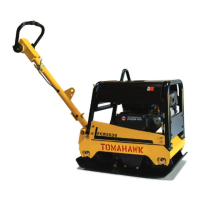19
7. COMPACTION TIPS
7.1 Soil Drop Test: Soil preparedness refers to the “wetness” of the dirt or soil. Soil needs to
be 50% dry and 50% wet, before starting compaction. A simple “hand test” can determine
this. Pick up a handful of soil with your hand and squeeze the dirt. Observe whether the soil
is powdery or if it breaks apart when dropped. If the soil does break apart, it means that it is
too dry. If the soil keeps together in one piece when dropped, it is ready for compaction.
7.2 Soil Testing: The function of this step is to measure the density of an aggregate material
to ensure the increase of density when driving out air. At a low moisture content level, there
are more soil particles assembling together. In order to determine if the soil is compacted
properly, there are several methods.
7.3 Test Strips: Test strips are useful to determine the method of compaction and
understand how many passes of your plate compactor are needed to achieve the optimum
compaction. Every layer of compacted soil meets a specific percentage on the proctor curve.
Through soil testing, it is possible to identify optimum moisture. Soil testing measures the
soil density compared to the degree of compaction specifications, as well as the effect of the
moisture.
A common laboratory method called the Proctor Compaction Test can be used to determine
the optimal moisture content for a given soil type. The goal of this method is to understand
the soil’s maximum dry density. A second method of soil testing is known as the California
Test 216 and is used to find the relative compaction of untreated and treated soils.
Four factors account for optimum compaction including li thickness, pressure, and soil
moisture content. During the compaction process, the soil's moisture adds density and
lubricates soil particles, until there is a maximum dry unit weight without voids in the soil.
The table below explains the different outcomes and properties of fill materials.

